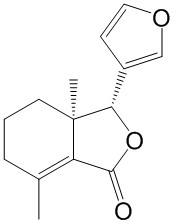Home
Products
Fraxinellone



| Product Name | Fraxinellone |
| Price: | $46 / 20mg |
| Catalog No.: | CN09502 |
| CAS No.: | 28808-62-0 |
| Molecular Formula: | C14H16O3 |
| Molecular Weight: | 232.28 g/mol |
| Purity: | >=98% |
| Type of Compound: | Sesquiterpenoids |
| Physical Desc.: | White powder |
| Source: | The root barks of Dictamnus dasycarpus Turcz. |
| Solvent: | Chloroform, Dichloromethane, Ethyl Acetate, DMSO, Acetone, etc. |
| SMILES: | CC1=C2C(=O)O[C@H]([C@@]2(CCC1)C)c1cocc1 |
| Contact us | |
|---|---|
| First Name: | |
| Last Name: | |
| E-mail: | |
| Question: | |
| Description | Fraxinellone is isolated from the root bark of the Rutaceae plant, Dictamnus dasycarpus. Fraxinellone is a PD-L1 inhibitor and inhibits HIF-1α protein synthesis without affecting HIF-1α protein degradation. Fraxinellone has the potential to be a valuable candidate for cancer treatment by targeting PD-L1[1]. |
| In Vitro | Fraxinellone (0-100 μM;12 hours) decreases the percent of PD-L1 positive cells from 20.4% to 11.4% in A549 cells[1]. Cell Viability Assay[1] Cell Line: A549 cells Concentration: 0 μM, 10 μM, 30 μM, 100 μM Incubation Time: 12 hours Result: Inhibited the percent of PD-L1 positive cells. |
| In Vivo | Fraxinellone (oral gavage; 30 and 100 mg/kg; every three days; 30 days) significantly suppresses tumor growth, reduces HIF-1α, pTyr705 STAT3, PD-L1 and VEGF staining compared with the control group in female athymic BALB/c nude mice[1]. Animal Model: BALB/c nude mice[1] Dosage: 30 and 100 mg/kg Administration: Oral gavage; 30 and 100 mg/kg; every three days; 30 days Result: Significantly suppressed tumor growth. |
| Density | 1.2±0.1 g/cm3 |
| Boiling Point | 372.9±30.0 °C at 760 mmHg |
| Flash Point | 179.3±24.6 °C |
| Exact Mass | 232.109940 |
| PSA | 39.44000 |
| LogP | 2.85 |
| Vapour Pressure | 0.0±0.8 mmHg at 25°C |